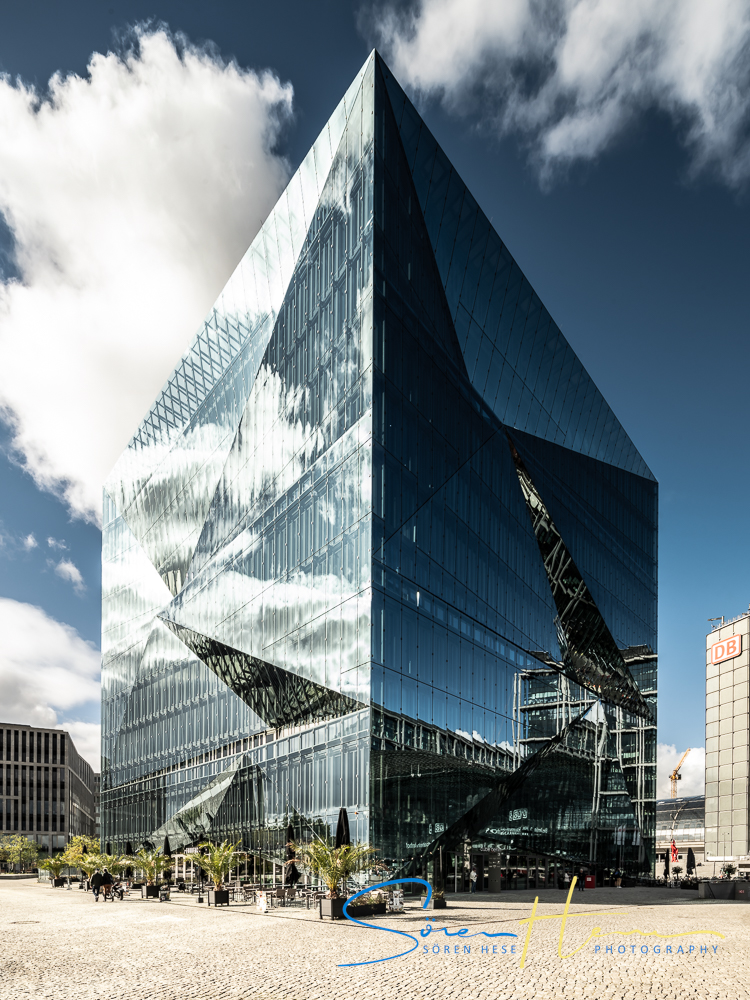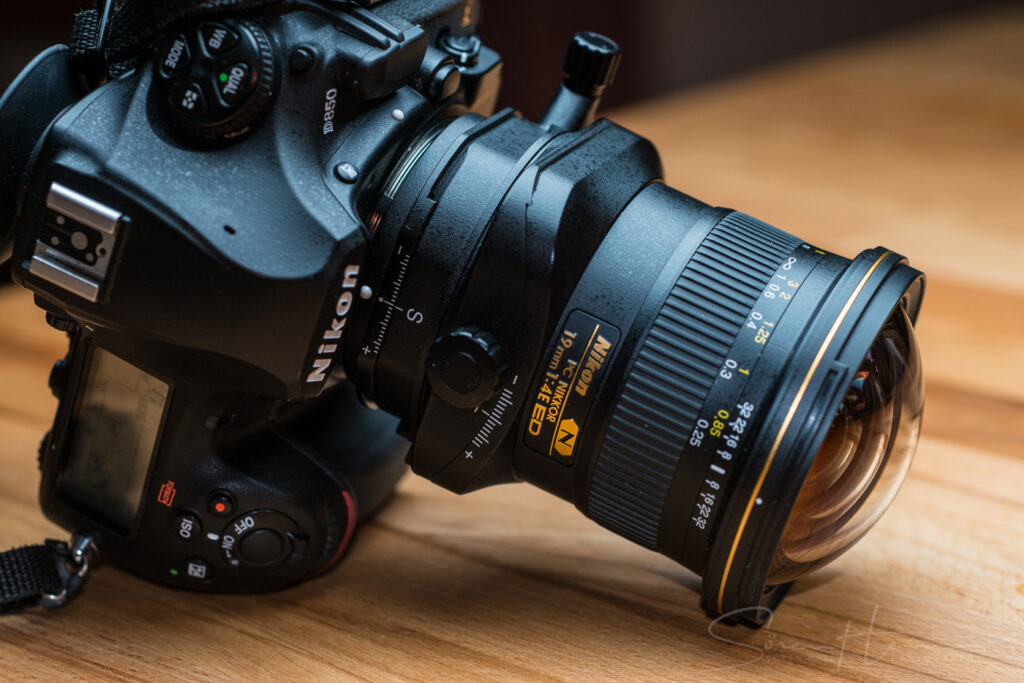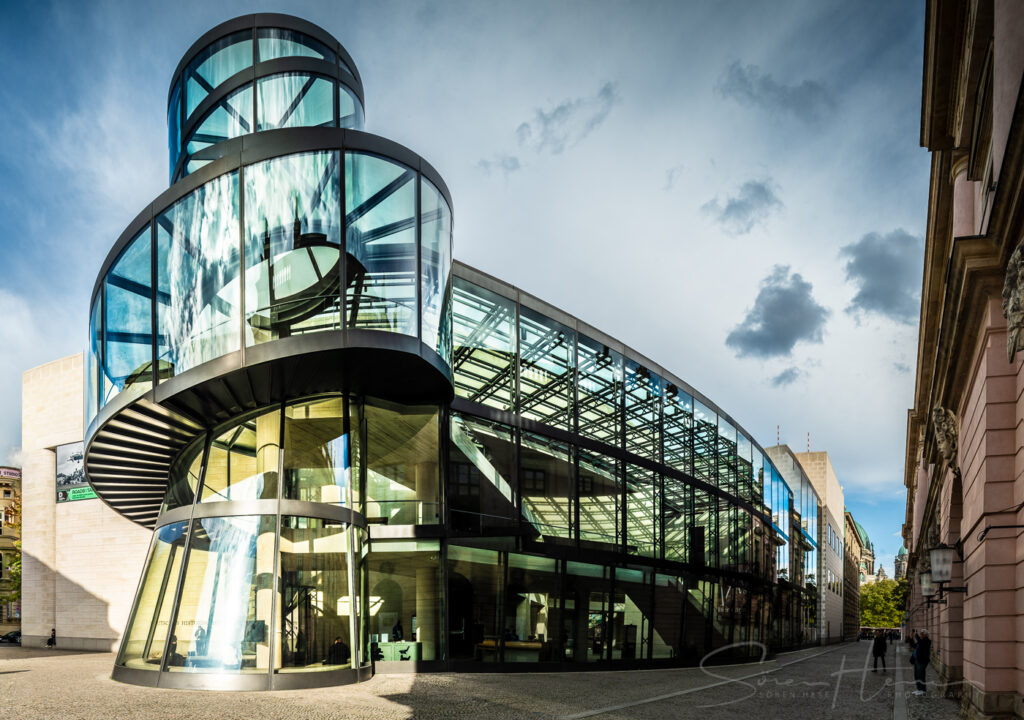Shooting the “19” leveled


Updated: 23.6.2025: surprising NIR performance of the 19mm.
The “19” – a tilt shift lens that was on my list since years – mainly for architecture and interiors but also for all urban night light adventures – here a short analysis of this lens and its potential for precise leveled shots . I will mirror this article on my sister site for urban night light shootings soon.
What’s the “19”? It’s the 19mm Tilt/Shift PC-E lens from Nikon – correctly named: Nikon PC-E 19mm f4E. This lens can be tilted by 7.5 degree and shifted 12mm in each direction. The tilt- and shift- axis can be twisted against each other – very handy. There are some other ultra wide T/S lenses on the market that kind of also come to mind when you are about to jump for an ultra wide tilt/shift lens – doesn’t matter what camera system you use since the Canon could be also used on a Nikon Z camera:
- Canon TS-E 17mm f4 L (made in Japan by Canon), Canon mount, full electronic contacts, 104 degree unshifted, 67.2 mm image circle diameter, 120.9° x 70.4° degree FOV shifted horizontally, 8 aperture blades, independent tilt and shift rotation, +/-6.5 ° tilt, 12mm shift, 820gr, no Canon lens barrel tripod collar but the Rogeti TSE frame can be used with Arca mount, lens price: 2000-2250€.
- Laowa 15mm f4.5R shift lens (only shifts) (made in China by Venus Optics), no electronic contacts – no EXIF data, 125.3° x 77.3° degree FOV shifted horizontally! R-Version has 14 aperture blades, non-R version only 5 aperture blades, 11 mm shift, no tilt, Laowa filter adapter available, Venuslens Laowa lens barrel tripod collar available for Arca mount, lens price: 1529-1599€ (R-version not widely available in 2023).
- PC Nikkor 19mm PC-E f4E ED tilt and shift (made in Japan by Nikon), Nikon F mount, full electronic contacts, 12mm shift, 97 degree FOV unshifted, 67.3 mm image circle diameter, 115.3° x 64.6° FOV shifted horizontally! (equals 12mm lens on FX) Nano Crystal & Fluorine Coatings , 2 asphericals & 3 ED elements, independent tilt and shift rotation, +/-7.5 ° tilt, +/-12mm shift, 885gr., Haida 150mm filter adapter available, barrel lens-collar available from iPhoto w Arca mount, lens price 3250 – 3800€.
Alle lenses have pro and cons. The Nikon and the Laowa seem to be sharper at the extreme edges than the Canon , when shifted all lenses need to be stopped down to f8 or even f11 to get to “excellent” in the shifted edges, the Laowa has no tilt option, the Canon has a reputation of very soft extreme corners when shifted with some discussions hinting towards an degradation process that is responsible for the focus decalibration – however this could be also a problem with only specific samples of the 17mm – hinting again towards higher sample variations and low quality control? (refocusing is needed for the shifted images). With the Laowa some reports indicate some decentering with some samples of the lens (left side is sharp while right is soft etc.). For the Nikon and the Laowa there exists a lens-barrel tripod adapter for parallax-free panorama shifting (you basically shift the camera not the lens – this avoids parallax offsets). The Canon and the Nikon have electronic contacts, the Laowa sends no metadata/EXIF – just nothing – to the camera and shifting is only 11 mm whereas Canon and Nikon do 12mm, the original non-R Laowa had bad bokeh, the R-Version with 14 blades has a nice sunstar and better bokeh. The Nikon has the best coatings and works best from the three when you are directly shooting into the sun, the Laowa is the widest – if you need an ultra wide the Laowa might be it but it flares more pronounced than the other two (update 24: the 10mm Laowa is available – but without shifting). The Nikon seems to have the edge when it comes to corner sharpness but very close with the Laowa that is much wider.
If you never use the tilt feature and dont need lens EXIF data, go for the Laowa (but check sharpness of your sample), if tilt is important go for the Canon or the Nikon. The Nikon is the most expensive, the Laowa is the widest and the cheapest. From the ergonomics point of view I believe the Nikkor is the best, it just has the right smooth focus ring dampening and the twist knob for the shifting is just perfectly set up. The Laowa might be the best solution if you need an extra wide shift lens. It is the widest shift lens available on the market right now (2023) with fully shifted 125 degree field of view. However having no electronic contacts means you have no EXIF data or aperture values about pictures from this lens in your database later (if not manually setup the lens-type in-camera).
So overall – lots of variables to look at when you want an ultra wide tilt/shift lens. And than you can also avoid this investment by just using the software approach. However for serious work this can quickly end in disappointments. In part of your image the digital keystone correction reduces your image resolution by factor 2-3 – also precise composition is very difficult when you do keystone correction in “post” – this can lead to objects that are cut-off from your composition. Usually it takes a lot of experience to compose correctly for post-processing keystone correction and you loose some megapixels in one direction – basically reducing a 48MP image partly to a 24MP image. For potentially large prints and commercial work this is not an option.

So you probably guessed it already: I really really love the 19mm, it’s just perfect in terms of handling, focus precision, image quality and sun star rendering. Its always inspiring to work with equipment that is not in your way – that works exactly as expected and feels precise – it motivates to be more careful / to dial in perfect settings and level the base precisely. Sometimes it feels as if a wider shift lens would be nice – so maybe the Laowa is on my list soon – we will see. But if I would order a Laowa I would get 3-4 samples and keep the sharpest – there seems to be sample variation at play with the Laowa-s.
When you found the right tilt and shift lens you will soon discover that a tilt-shift always comes with a tripod and a leveling base – things get really tricky here since the tripod market is incredible divers. The tripod leveling head market however is not – you just have to pay much more than expected to get equipment that will stand the wear and tear of time. Ultimately you want something like a Gitzo Systematic Series 4 or 5 carbon tripod (with 4 or 5 legs) (made in Italy) and an Arca Swiss Cube C1 or at least a Leofoto G20 (made in China) or the Gitzo Systematic leveling base although the GSLVLS isn’t substituting a C1. The more affordable solution these days would be a Leofoto Ranger tripod (made in China) or a Manfrotto 050 tripod. Cheaper geared leveling base goes using the G2 from Leofoto or the Manfrotto 405 or 410 heads. This allows precise and very controlled absolutely leveled shots. Clearly a more heavy investment when you are not constantly doing these kind of shootings for payed client work. However – compared to digital camera bodies you will only buy once when you find the perfect tripod legs and the perfect ball-head and leveling base. These investments will always pay back when you are serious about what you do and value-depreciation is very low with this equipment even when you take into account wear and tear. Its the very opposite with digital camera bodies. These loose nearly as much in value as cars.
While I really like the Systematic Gitzo legs (you can hardly go wrong here with any of these Gitzo tripods) I am a wee bit reluctant about the Gitzo Ball Heads. When you turn the locking knob of some of the Gitzo Heads too much these knobs just dismount (happened with a series 4 and my series 1 traveller head). This is clearly not so nice imo. The Arca Style clamping system is screwed to the head with two tiny hex screws f.e. on the GH4383LR – and not compatible with the pano heads f.e. from RRS.
The way I work with the 19mm is pretty much bolting it down to my GT4543LS or to the GT3541 – both work nicely but for urban shots I prefer the 4543 over the series 3 using a geared head on Arca style L-plates. Gitzo’s tripod naming system is pretty easy to understand once you digest what all the numbers stand for. The first number is for the series (leg diameter), the second is for material (carbon is 5), the third is for no. of leg-sections (4 sections) and the last is for the versioning of the tripod (third version of the systematic tripods). So for the Systematic line basically you want something like the 4553 for nature and wildlife or interior, the 4543/5543 or the 5563 for architecture – also work nicely in the studio and the series 3 likely for when you do hikes – but some find the series 3 much too heavy for that and for those the Mountaineer- or Traveller-Series is there … ;-).
The 19mm is usually leveled with my Leo G20 and I also use an Haida neutral grey filter adapter on my 19 for long exposure times. For indoor paralaxe-free shifting I use the iphoto 19mm collar but this is not a perfect solution and I try to find a different collar.
Once the setup is leveled you can easily shift up to correct your composition or flip 90 degree and do very parallax-free 3-shot panoramas. Focusing the lens precisely is a challenge – you clearly need live view and magnification to exactly nail the focusing. I usually use additionally a Zakuto viewfinder that lets mit analyze the focus slice exactly. For best lens performance I go to f8 or f11. I would not close down the lens any further since diffraction sneaks in and the lens slowly looses sharpness. Focusing the lens is clearly also fun because the lens focus ring is just so nicely smooth and perfectly dampened that precise setup is fun. However the focus throw is short – you have to be careful not to touch the focus ring when everything is adjusted. You easily defocus the lens.
The lens manual from Nikon tries to explain in detail how and when to shift and tilt. You better read the following site https://www.cambridgeincolour.com/tutorials/tilt-shift-lenses1.htm for shifting and here https://www.cambridgeincolour.com/tutorials/tilt-shift-lenses2.htm for tilting, but to be fair Nikon tries hard in their leaflet to show how it works. For me its shifting for architecture and tilting for defocus blur effects – I rarely use the tilt to increase the depth of field. But the original idea was to increase the depth of field by moving the focal level into space forming a wedge which broadens away from the camera following the Scheimpflug principle.
Update 23.06.25: the lens works surprisingly well with the NIR (850nm cut) converted D800! This was something I only lately in 2025 detected. The lens has no hotspot and most importantly it keeps its sharpness into the edges quite well – much better than the F mount version of the 14-24mm AFS lens – even shifted the lens works nicely in NIR when set to f9 or so. Usually with the strong filter cut at 850nm with most lense the corners stay muddy but not with the 19.

